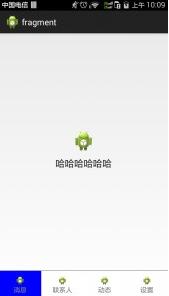现在的APP首页大部分屏幕的下方显示一行Tab标签选项,点击不同的标签就可以切换到不同的界面。如下图:

我们之前都是用TabHost来实现,但是殊不知,TabHost并非是那么的简单,它的可扩展性非常的差,不能随意地定制Tab项显示的内容,而且运行还要依赖于ActivityGroup。ActivityGroup原本主要是用于为每一个TabHost的子项管理一个单独的Activity,但目前已经被废弃了。下面就借助Fragment来完成类似于TabHost一般的效果。
先实现主界面布局main_layout.xml:
<LinearLayout xmlns:android="http://schemas.android.com/apk/res/android" android:layout_width="match_parent" android:layout_height="match_parent" android:orientation="vertical" > <FrameLayout android:id="@+id/content" android:layout_width="match_parent" android:layout_height="0dp" android:layout_weight="1" > </FrameLayout> <View android:layout_width="match_parent" android:layout_height="0.5dp" android:background="#000000" /> <LinearLayout android:layout_width="match_parent" android:layout_height="60dp" android:background="#ffffff" android:orientation="horizontal" > <RelativeLayout android:id="@+id/message_layout" android:layout_width="0dp" android:layout_height="match_parent" android:layout_weight="1" > <LinearLayout android:layout_width="match_parent" android:layout_height="wrap_content" android:layout_centerVertical="true" android:orientation="vertical" > <ImageView android:id="@+id/message_image" android:layout_width="20dp" android:layout_height="20dp" android:layout_gravity="center_horizontal" android:src="@drawable/ic_launcher" /> <TextView android:id="@+id/message_text" android:layout_width="wrap_content" android:layout_height="wrap_content" android:layout_gravity="center_horizontal" android:text="消息" android:textColor="#82858b" /> </LinearLayout> </RelativeLayout> <View android:layout_width="0.5dp" android:layout_height="match_parent" android:background="#000000" /> <RelativeLayout android:id="@+id/contacts_layout" android:layout_width="0dp" android:layout_height="match_parent" android:layout_weight="1" > <LinearLayout android:layout_width="match_parent" android:layout_height="wrap_content" android:layout_centerVertical="true" android:orientation="vertical" > <ImageView android:id="@+id/contacts_image" android:layout_width="20dp" android:layout_height="20dp" android:layout_gravity="center_horizontal" android:src="@drawable/ic_launcher" /> <TextView android:id="@+id/contacts_text" android:layout_width="wrap_content" android:layout_height="wrap_content" android:layout_gravity="center_horizontal" android:text="联系人" android:textColor="#82858b" /> </LinearLayout> </RelativeLayout> <View android:layout_width="0.5dp" android:layout_height="match_parent" android:background="#000000" /> <RelativeLayout android:id="@+id/news_layout" android:layout_width="0dp" android:layout_height="match_parent" android:layout_weight="1" > <LinearLayout android:layout_width="match_parent" android:layout_height="wrap_content" android:layout_centerVertical="true" android:orientation="vertical" > <ImageView android:id="@+id/news_image" android:layout_width="20dp" android:layout_height="20dp" android:layout_gravity="center_horizontal" android:src="@drawable/ic_launcher" /> <TextView android:id="@+id/news_text" android:layout_width="wrap_content" android:layout_height="wrap_content" android:layout_gravity="center_horizontal" android:text="动态" android:textColor="#82858b" /> </LinearLayout> </RelativeLayout> <View android:layout_width="0.5dp" android:layout_height="match_parent" android:background="#000000" /> <RelativeLayout android:id="@+id/setting_layout" android:layout_width="0dp" android:layout_height="match_parent" android:layout_weight="1" > <LinearLayout android:layout_width="match_parent" android:layout_height="wrap_content" android:layout_centerVertical="true" android:orientation="vertical" > <ImageView android:id="@+id/setting_image" android:layout_width="20dp" android:layout_height="20dp" android:layout_gravity="center_horizontal" android:src="@drawable/ic_launcher" /> <TextView android:id="@+id/setting_text" android:layout_width="wrap_content" android:layout_height="wrap_content" android:layout_gravity="center_horizontal" android:text="设置" android:textColor="#82858b" /> </LinearLayout> </RelativeLayout> </LinearLayout> </LinearLayout>
这段布局代码虽然有点长,但其实主要就分为两部分。第一个部分就是FrameLayout,这里只是给FrameLayout的id设置成content,并没有在里面添加任何具体的内容,因为具体的内容是要在后面动态进行添加的。第二个部分就是FrameLayout下面的LinearLayout,这个LinearLayout中包含的就是整个类似于TabHost的布局。可以看到,我们将这个LinearLayout又等分成了四份,每一份中都会显示一个ImageView和一个TextView。ImageView用于显示当前Tab的图标,TextView用于显示当前Tab的标题。
既然是等分成了四分,那接下来我们自然要去分别实现四个Fragment和它们的布局了。新建一个message_layout.xml作为消息界面的布局,代码如下所示:
<?xml version="1.0" encoding="utf-8"?> <RelativeLayout xmlns:android="http://schemas.android.com/apk/res/android" android:layout_width="match_parent" android:layout_height="match_parent" > <LinearLayout android:layout_width="wrap_content" android:layout_height="wrap_content" android:layout_centerInParent="true" android:orientation="vertical" > <ImageView android:layout_width="wrap_content" android:layout_height="wrap_content" android:layout_gravity="center_horizontal" android:src="@drawable/ic_launcher" /> <TextView android:id="@+id/message" android:layout_width="wrap_content" android:layout_height="wrap_content" android:layout_gravity="center_horizontal" android:padding="10dp" android:text="这是消息界面" android:textSize="20sp" /> </LinearLayout> </RelativeLayout>
其他三个界面类似就不一 一列出。然后要去创建对应这个布局的Fragment。新建MessageFragment继承自Fragment,代码如下所示:
public class MessageFragment extends Fragment{
private TextView tv;
public View onCreateView(LayoutInflater inflater, ViewGroup container,
Bundle savedInstanceState) {
View messageLayout = inflater.inflate(R.layout.message, container, false);
tv=(TextView) messageLayout.findViewById(R.id.message);
tv.setText("哈哈哈哈哈哈");
return messageLayout;
}
}
我们也依次创建其他三个布局的Fragment。最后是MainActivity,代码如下:
public class MainActivity extends Activity implements OnClickListener {
/**
* 用于展示消息的Fragment
*/
private MessageFragment messageFragment;
/**
* 用于展示联系人的Fragment
*/
private ContactsFragment contactsFragment;
/**
* 用于展示动态的Fragment
*/
private NewsFragment newsFragment;
/**
* 用于展示设置的Fragment
*/
private SettingFragment settingFragment;
/**
* 消息界面布局
*/
private View messageLayout;
/**
* 联系人界面布局
*/
private View contactsLayout;
/**
* 动态界面布局
*/
private View newsLayout;
/**
* 设置界面布局
*/
private View settingLayout;
/**
* 用于对Fragment进行管理
*/
private FragmentManager fragmentManager;
@Override
protected void onCreate(Bundle savedInstanceState) {
super.onCreate(savedInstanceState);
setContentView(R.layout.activity_main);
initViews();
fragmentManager = getFragmentManager();
// 第一次启动时选中第0个tab
setTabSelection(0);
}
/**
* 在这里获取到每个需要用到的控件的实例,并给它们设置好必要的点击事件。
*/
private void initViews() {
messageLayout = findViewById(R.id.message_layout);
contactsLayout = findViewById(R.id.contacts_layout);
newsLayout = findViewById(R.id.news_layout);
settingLayout = findViewById(R.id.setting_layout);
messageLayout.setOnClickListener(this);
contactsLayout.setOnClickListener(this);
newsLayout.setOnClickListener(this);
settingLayout.setOnClickListener(this);
}
@Override
public void onClick(View v) {
switch (v.getId()) {
case R.id.message_layout:
// 当点击了消息tab时,选中第1个tab
setTabSelection(0);
break;
case R.id.contacts_layout:
// 当点击了联系人tab时,选中第2个tab
setTabSelection(1);
break;
case R.id.news_layout:
// 当点击了动态tab时,选中第3个tab
setTabSelection(2);
break;
case R.id.setting_layout:
// 当点击了设置tab时,选中第4个tab
setTabSelection(3);
break;
default:
break;
}
}
/**
* 根据传入的index参数来设置选中的tab页。
*
* @param index
* 每个tab页对应的下标。0表示消息,1表示联系人,2表示动态,3表示设置。
*/
private void setTabSelection(int index) {
// 每次选中之前先清楚掉上次的选中状态
clearSelection();
// 开启一个Fragment事务
FragmentTransaction transaction = fragmentManager.beginTransaction();
// 先隐藏掉所有的Fragment,以防止有多个Fragment显示在界面上的情况
hideFragments(transaction);
switch (index) {
case 0:
messageLayout.setBackgroundColor(0xff0000ff);
if (messageFragment == null) {
// 如果MessageFragment为空,则创建一个并添加到界面上
messageFragment = new MessageFragment();
transaction.add(R.id.content, messageFragment);
} else {
// 如果MessageFragment不为空,则直接将它显示出来
transaction.show(messageFragment);
}
break;
case 1:
// 当点击了联系人tab时,改变控件的图片和文字颜色
contactsLayout.setBackgroundColor(0xff0000ff);
if (contactsFragment == null) {
// 如果ContactsFragment为空,则创建一个并添加到界面上
contactsFragment = new ContactsFragment();
transaction.add(R.id.content, contactsFragment);
} else {
// 如果ContactsFragment不为空,则直接将它显示出来
transaction.show(contactsFragment);
}
break;
case 2:
// 当点击了动态tab时,改变控件的图片和文字颜色
newsLayout.setBackgroundColor(0xff0000ff);
if (newsFragment == null) {
// 如果NewsFragment为空,则创建一个并添加到界面上
newsFragment = new NewsFragment();
transaction.add(R.id.content, newsFragment);
} else {
// 如果NewsFragment不为空,则直接将它显示出来
transaction.show(newsFragment);
}
break;
case 3:
default:
// 当点击了设置tab时,改变控件的图片和文字颜色
settingLayout.setBackgroundColor(0xff0000ff);
if (settingFragment == null) {
// 如果SettingFragment为空,则创建一个并添加到界面上
settingFragment = new SettingFragment();
transaction.add(R.id.content, settingFragment);
} else {
// 如果SettingFragment不为空,则直接将它显示出来
transaction.show(settingFragment);
}
break;
}
transaction.commit();
}
/**
* 将所有的Fragment都置为隐藏状态。
*
* @param transaction
* 用于对Fragment执行操作的事务
*/
private void hideFragments(FragmentTransaction transaction) {
if (messageFragment != null) {
transaction.hide(messageFragment);
}
if (contactsFragment != null) {
transaction.hide(contactsFragment);
}
if (newsFragment != null) {
transaction.hide(newsFragment);
}
if (settingFragment != null) {
transaction.hide(settingFragment);
}
}
/**
* 清除掉所有的选中状态。
*/
private void clearSelection() {
messageLayout.setBackgroundColor(0xffffffff);
contactsLayout.setBackgroundColor(0xffffffff);
newsLayout.setBackgroundColor(0xffffffff);
settingLayout.setBackgroundColor(0xffffffff);
}
}
这样就实现了上面图中的效果了。
以上就是本文的全部内容,希望对大家的学习有所帮助,也希望大家多多支持自由互联。
